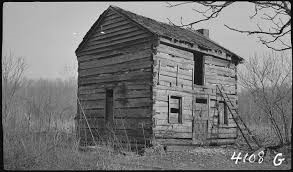
An extremely extravagant prairie home made of hand-hewn wood from the 1850s. (commons.wikimedia.org)
Much of Texas is covered with open prairies interspersed with rivers, streams, and creeks. These waterways are filled with trees, brush, and vines, are known as thickets. Many Texans know the thickets as hiding places for outlaws, deserters, and refuge for wildlife, yet there was a vital use for the thickets.
When Native Americans occupied the prairies, they burned off the grasses and thickets in early spring for new grass to grow. Perhaps you have heard about this in discussions of California’s deadly fires. Undergrowth causes fires to spread quickly. But clearing the underbrush allows tall, fertile grass to take over.
The thickets, though, are filled with valuable trees for those living on prairies. Trees or timber once trees were cut were necessities for early settlers. It was the sole source of fuel and building materials. Pioneers claimed lands on prairies for ranging livestock, growing wheat or corn, and later raising cotton. If there were no trees adjacent to those prairies, they went into the thickets and claimed several acres for fuel. These plots were usually long and narrow.
However, farmers and stockmen found it unreasonable to go to the woods every week. It became a chore for late fall. Crops were in, the weather was still crisp but not too cold, and they enjoyed campouts as much as deer hunters do today. Many men had at least one wagon; two were even better.
Often the farmer took at least two of his sons, saws, axes, and camping gear. Once a spot was chosen, they began to cut down trees sawing the wood into logs for use in chimneys or later wood stoves. It was a hard, tiring chose. Before Emancipation in 1865, slaves did all the hard work. If the farmer owned no slaves, he sometimes hired one or two for the task.
The first settlers cut longer logs to use for a home. Neighbors gathered to help build the new home and creating a social gathering. By the early 1840s steamboats navigated the bayous near Jefferson, Texas, enough to haul fine lumber for sale in the thriving new town. Many early settlers with money bought such goods to furnish log-cabin replacements. By the middle of the 1850s, settlers were cutting oaks and walnut trees in the Sabine bottomland to use for homes. Now log cabins were replaced by frame houses, at least in Greenville.
These new homes were cheaper than hauling fine lumber from Jefferson. Since there was little actual cash in Hunt County at that time, it was a more practical alternative.
Finding fuel in the thickets to warm homes and to cook with continued for many, many years. Such practices came with hazards, though. Not only did fires haunt Greenville, but also so the entire country. The worst fire occurred in 1883 when the new Ende Hotel completely burned down. It was located at the southeast corner of the square. The entire south side and west side of the square were also destroyed. Greenville had no fire-fighting equipment at that time.
The mayor quickly sent a telegram to officials in Sherman where their fire-equipment was loaded on a flat car, raced down the railroad tracks, and managed to assist in putting out the final portion of the fire. Fires continued, but none as deadly as the Ende Hotel fire. It was in the 1905 before artificial gas and then natural gas replaced wood fires. At the same time Greenville developed its own electric company. But many families found the cost to convert to these new fangled energy sources entirely too extravagant.
Today Greenville has much safer ways to heat homes and cook food and fewer home fires. However, there’s nothing more inviting than a warm fire on a cold evening.
